跨文化语用学crossculturalpragmatics
- 格式:ppt
- 大小:2.21 MB
- 文档页数:30


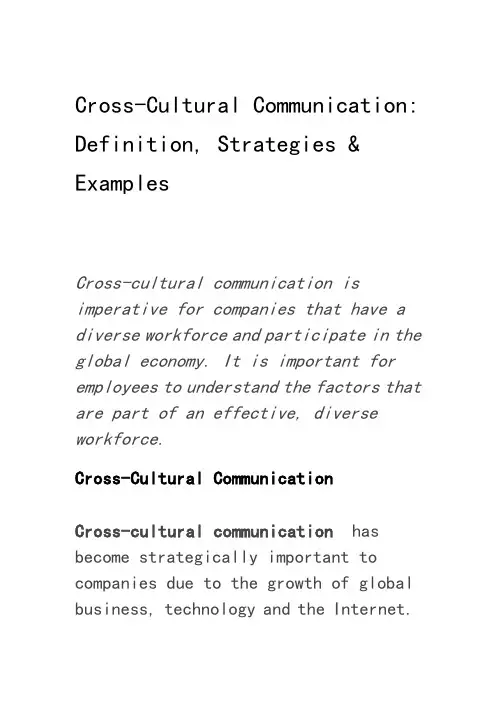
Cross-Cultural Communication: Definition, Strategies & ExamplesCross-cultural communication is imperative for companies that have a diverse workforce and participate in the global economy. It is important for employees to understand the factors that are part of an effective, diverse workforce.Cross-Cultural CommunicationCross-cultural communication has become strategically important to companies due to the growth of global business, technology and the Internet.Understanding cross-cultural communication is important for any company that has a diverse workforce or plans on conducting global business. This type of communication involves an understanding of how people from different cultures speak, communicate and perceive the world around them.Cross-cultural communication in an organization deals with understanding different business customs, beliefs and communication strategies. Language differences, high-context vs.low-context cultures, nonverbal differences and power distance are major factors that can affectcross-cultural communication.Let's take a look at how cross-cultural differences can cause potential issues within an organization. Jack is amanager at a New Mexico-based retail conglomerate. He has flown to Japan to discuss a potential partnership with a local Japanese company. His business contact, Yamato, is his counterpart within the Japanese company. Jack has never been to Japan before, and he's not familiar with their cultural norms. Let's look at some of the ways that a lack of cultural understanding can create a barrier for business success by examining how Jack handles his meeting with Yamato.High- Vs. Low-Context CultureThe concept of high- and low-context culture relates to how an employee's thoughts, opinions, feelings and upbringing affect how they act within a given culture. North America and Western Europe are generally consideredto have low-context cultures. This means that businesses in these places have direct, individualistic employees who tend to base decisions on facts. This type of businessperson wants specifics noted in contracts and may have issues with trust.High-context cultures are the opposite in that trust is the most important part of business dealings. There are areas in the Middle East, Asia and Africa that can be considered high context. Organizations that havehigh-context cultures are collectivist and focus on interpersonal relationships. Individuals fromhigh-context cultures might be interested in getting to know the person they are conducting business with in order to get a gut feeling on decision making. They may also be more concernedabout business teams and group success rather than individual achievement.Jack and Yamato ran into some difficulties during their business negotiations. Jack spoke quickly and profusely because he wanted to seal the deal as soon as possible. However, Yamato wanted to get to know Jack, and he felt that Jack spoke too much. Yamato also felt that Jack was only concerned with completing the deal for his own self-interest and was not concerned with the overall good of the company. Jack's nonverbal cues did not help the negotiations either.Nonverbal DifferencesGestures and eye contact are two areas of nonverbal communication that areutilized differently across cultures. Companies must train employees in the correct way to handle nonverbal communication as to not offend other cultures. For example, American workers tend to wave their hand and use a finger to point when giving nonverbal direction. Extreme gesturing is considered rude in some cultures. While pointing may be considered appropriate in some contexts in the United States, Yamato would never use a finger to point towards another person because that gesture is considered rude in Japan. Instead, he might gesture with an open hand, with his palm facing up, toward the person.Eye contact is another form of nonverbal communication. In the ., eye contact is a good thing and is seen as a reflection of honesty and straightforwardness.However, in some Asian and Middle Eastern cultures, prolonged eye contact can be seen as rude or aggressive in many situations. Women may need to avoid it altogether because lingering eye contact can be viewed as a sign of sexual interest. During their meeting, Jack felt that Yamato was not listening to his talking points because Yamato was not looking Jack in the eyes. However, Yamato did not want Jack to think he was rude, so he avoided looking directly into Jack's eyes during his speech.Language DifferencesThe biggest issue dealing withcross-cultural communication is the difficulty created by language barriers. For example, Jack does not speak Japanese, so he is concerned with his ability to communicate effectively withYamato. There are some strategies that Jack can use to help establish a rapport with Yamato. Jack can explain himself without words by using emotions, facial expressions and other nonverbal cues. He can also use drawings and ask for an interpreter.Additionally, companies that have to deal with cross-cultural communication can hire employees with proficiency in other languages. Fortunately for Jack and Yamato, they both had excellent translators who communicated their words. The next cross-cultural issue regards how individuals deal with power distance.Power DistancePower distance relates to how power is distributed within an organization. Typically, American companies utilize a low power distance and have more informal hierarchies that allow for interaction between executives and their subordinates. Managers ask for feedback from employees and will even socialize with subordinates. Companies with high power distance are typically very hierarchical in nature and have severe differences in authority. Some Japanese companies may utilize this power structure.。

跨文化语用失误与语境郑宏伟(广东茂名学院师范学院外语系,广东茂名 525000)摘要:跨文化交际语用失误是指在跨文化交际中由于交际者使用语言不得体而导致误解和冲突的现象。
在跨文化交际中交际者要进行成功的交际除了要掌握文化交际所需要的语言结构外还必须注意语境的因素,懂得如何联系语境根据交际对象的不同恰当地使用语言,否则可能引起语用失误。
本论文从语境角度讨论了由于没有充分考虑交际对象的社会角色、语体选择不当或不能正确选择语义而造成的跨文化交际语用失误现象。
关键词:跨文化;语用失误;语境1. 引言跨文化语用失误是近年来语用学和跨文化交际学研究的热点问题。
英国语言学家詹尼·托马斯(Jenny Thomas)对跨文化语用失误的研究具有开创性。
托马斯在1983年发表的《跨文化语用失误》一文中首次提出语用失误(Pragmatic Failure)这一概念。
托马斯认为语用失误是指“不能理解话语的含义,语用失误可分为语言的语用失误和社会语用失误”(J.Thomas, 1983: 91)。
跨文化交际中的语用失误是指不同文化的交际者在交际过程中出现语用失误而导致的误解、矛盾及冲突等现象。
语言的运用总是处在一定的语言环境中,语境涉及语言交际的现实环境或具体情景,它由一系列同语言交际密切相关的主客观环境因素构成。
这些因素为决定了语言表达的特定意义。
语境给我们提供了研究如何参与交际以及在交际中如何发挥作用的基础。
当词语进入到具体的语言活动后,它所具有的语义是非常丰富而又非常复杂的,有语言本身的意义,还有环境给予语言的意义。
这些丰富而又复杂的语义,不能只从词汇意义和语法意义去理解,而要联系语境进行分析。
语境因素在不同角度不同层次对具体语言手段的选择和组合产生影响,对语言运用起到制约作用。
我们在跨文化交际过程中应充分注意语境因素对语言运用的影响,否则容易导致语用失误现象的发生。
2. 语境1923年波兰籍人类语言学家马里诺夫斯基提出情景语境的概念,认为交际环境对于语言交际来说是不能缺少的部分。


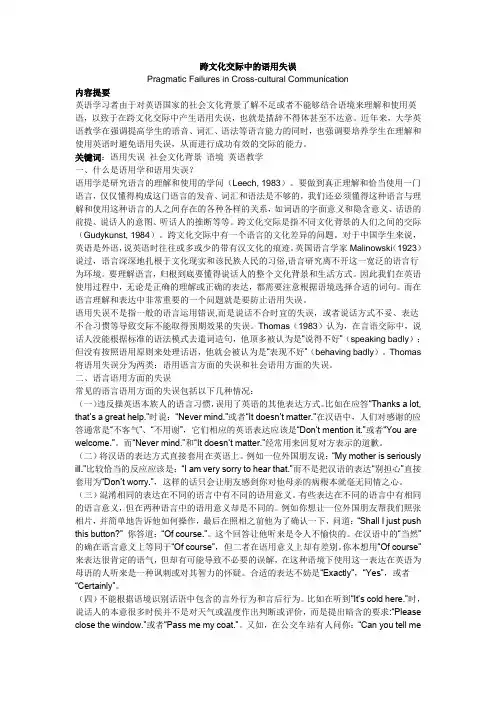
跨文化交际中的语用失误Pragmatic Failures in Cross-cultural Communication内容提要英语学习者由于对英语国家的社会文化背景了解不足或者不能够结合语境来理解和使用英语,以致于在跨文化交际中产生语用失误,也就是措辞不得体甚至不达意。
近年来,大学英语教学在强调提高学生的语音、词汇、语法等语言能力的同时,也强调要培养学生在理解和使用英语时避免语用失误,从而进行成功有效的交际的能力。
关键词:语用失误社会文化背景语境英语教学一、什么是语用学和语用失误?语用学是研究语言的理解和使用的学问(Leech, 1983)。
要做到真正理解和恰当使用一门语言,仅仅懂得构成这门语言的发音、词汇和语法是不够的,我们还必须懂得这种语言与理解和使用这种语言的人之间存在的各种各样的关系,如词语的字面意义和隐含意义、话语的前提、说话人的意图、听话人的推断等等。
跨文化交际是指不同文化背景的人们之间的交际(Gudykunst, 1984)。
跨文化交际中有一个语言的文化差异的问题。
对于中国学生来说,英语是外语,说英语时往往或多或少的带有汉文化的痕迹。
英国语言学家Malinowski(1923)说过,语言深深地扎根于文化现实和该民族人民的习俗,语言研究离不开这一宽泛的语言行为环境。
要理解语言,归根到底要懂得说话人的整个文化背景和生活方式。
因此我们在英语使用过程中,无论是正确的理解或正确的表达,都需要注意根据语境选择合适的词句。
而在语言理解和表达中非常重要的一个问题就是要防止语用失误。
语用失误不是指一般的语言运用错误,而是说话不合时宜的失误,或者说话方式不妥、表达不合习惯等导致交际不能取得预期效果的失误。
Thomas(1983)认为,在言语交际中,说话人没能根据标准的语法模式去遣词造句,他顶多被认为是“说得不好”(speaking badly);但没有按照语用原则来处理话语,他就会被认为是“表现不好”(behaving badly)。
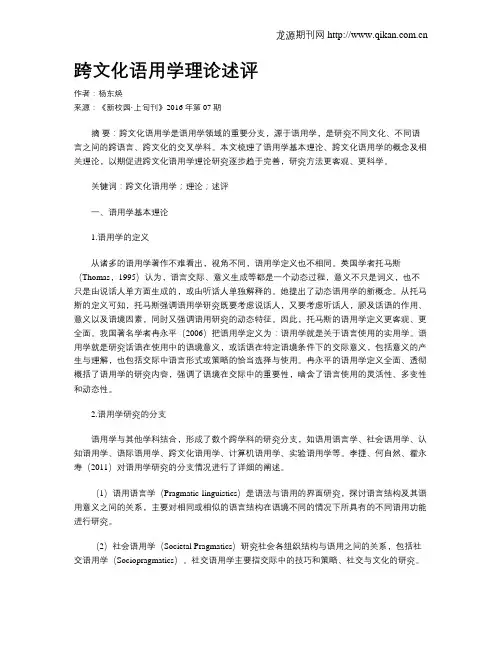
跨文化语用学理论述评作者:杨东焕来源:《新校园·上旬刊》2016年第07期摘要:跨文化语用学是语用学领域的重要分支,源于语用学,是研究不同文化、不同语言之间的跨语言、跨文化的交叉学科。
本文梳理了语用学基本理论、跨文化语用学的概念及相关理论,以期促进跨文化语用学理论研究逐步趋于完善,研究方法更客观、更科学。
关键词:跨文化语用学;理论;述评一、语用学基本理论1.语用学的定义从诸多的语用学著作不难看出,视角不同,语用学定义也不相同。
英国学者托马斯(Thomas,1995)认为,语言交际、意义生成等都是一个动态过程,意义不只是词义,也不只是由说话人单方面生成的,或由听话人单独解释的。
她提出了动态语用学的新概念。
从托马斯的定义可知,托马斯强调语用学研究既要考虑说话人,又要考虑听话人,顾及话语的作用、意义以及语境因素,同时又强调语用研究的动态特征。
因此,托马斯的语用学定义更客观、更全面。
我国著名学者冉永平(2006)把语用学定义为:语用学就是关于语言使用的实用学。
语用学就是研究话语在使用中的语境意义,或话语在特定语境条件下的交际意义,包括意义的产生与理解,也包括交际中语言形式或策略的恰当选择与使用。
冉永平的语用学定义全面、透彻概括了语用学的研究内容,强调了语境在交际中的重要性,暗含了语言使用的灵活性、多变性和动态性。
2.语用学研究的分支语用学与其他学科结合,形成了数个跨学科的研究分支,如语用语言学、社会语用学、认知语用学、语际语用学、跨文化语用学、计算机语用学、实验语用学等。
李捷、何自然、霍永寿(2011)对语用学研究的分支情况进行了详细的阐述。
(1)语用语言学(Pragmatic-linguistics)是语法与语用的界面研究,探讨语言结构及其语用意义之间的关系,主要对相同或相似的语言结构在语境不同的情况下所具有的不同语用功能进行研究。
(2)社会语用学(Societal Pragmatics)研究社会各组织结构与语用之间的关系,包括社交语用学(Sociopragmatics)。

跨文化语用学概述摘要:跨文化语用学是语言学研究的一个新兴学科,其形成是不同文化下的人类交际的结果,该文对跨文化语用学的兴起和发展,学科性质、研究方法和内容以及功能对等问题等进行梳理和概述。
关键词:跨文化语用学;人际交际;研究;功能对等一引言语用学(pragmatics)作为一门独立学科是从20世纪70年代开始的。
人们对其研究的范围有不同的看法,有的语言学家认为语用学研究的是“使用中的意义”,有的语用学家认为语用学研究的是“相互作用中的意义”。
大家普遍认为语用学研究的是说话者的意义,而不是词或者是句子的意思。
也就是说,语用学研究一般都是以某种文化为背景的。
20世纪80年代以来,语用学研究有了新的发展,开辟了许多新领域。
跨文化语言学(cross-cultural pragmatics )是在语言学和对比语言学研究的基础上发展起来的一门新兴学科,是将文化因素引入跨文化交际中意义研究的一种宽泛的语用学,主要研究不同文化背景的人进行交际的语用问题。
跨文化语用学着眼于不同语言的表层形态,结构方式和话语意义等的比较,深入到语言的深层文化内涵,关注动态语用的文化差异,语用主体的语用策略等,体现出较强的理论性和系统性。
概括来说,跨文化语用学重点在于分析不同文化背景的人之间直接交际过程中的语用现象及规律。
在英语文献中,跨文化通常用inter-cultural和cross-cultural两个术语来表示。
就跨文化交际而言, inter-cultural communication的研究不只对言语交际感兴趣, 它还力图对影响跨文化交际的各种因素作出解释。
它研究的重要是在非语言的文化因素上, 尽管不否认语言在体现文化差异上的重要性, 但文化问题似乎比语言问题更为重要。
而跨文化语用学( cross- cultural pragmatics) 强调不同文化背景的人之间的交际研究。
所以, 跨文化语用学中的跨文化我们用cross-cultural 而不用inter- cultural。
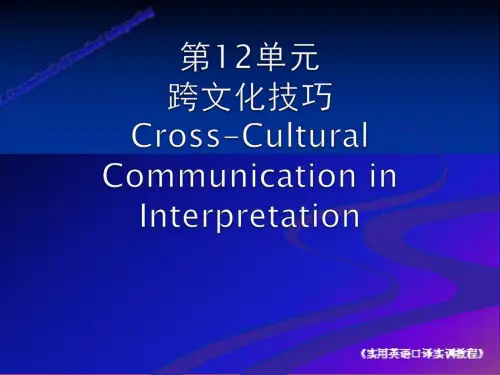
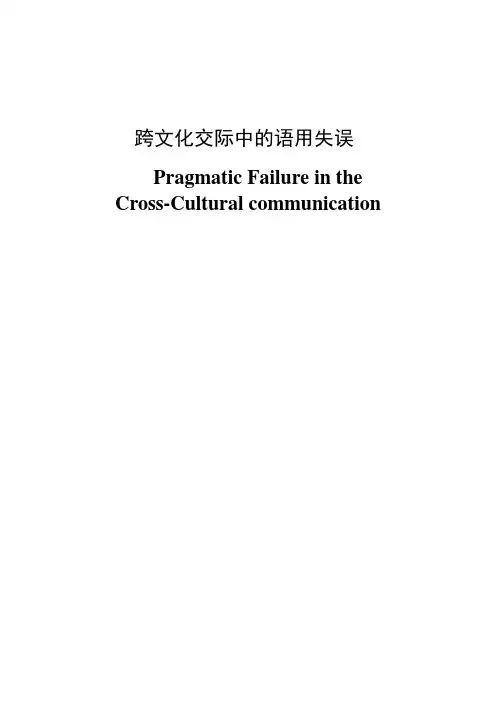
英汉礼貌语的语用差异摘要:使用礼貌语是不同的社会群体共有的普遍现象,是人类社会文明的标志。
然而由于受不同文化的制约,英汉礼貌用语也有所不同。
本文试从英汉两种不同语言的礼貌原则入手,通过对英汉礼貌用语的语用差异进行对比,分析其产生的原因,期望减少跨文化交际过程中的误解和文化冲突,使说话者成功进行跨文化交际。
关键词:礼貌语、语用差异、跨文化交际Pragmatic Discrepancies of Politeness in Chinese and Englishfrom the Point of Cross-cultural CommunicationAbstract:The use of politeness is a common phenomenon in various societies and groups, and it is the mark of human social civilization.However, affected by different cultures, politeness has specific characteristics. Aiming at reducing misunderstanding and cultural conflict and promoting successful communication in the process of cross-cultural communication, this paper begins with the different principles of politeness, contrasts the pragmatic discrepancies of politeness and analyzes the causes for the differences in Chinese and English.Key words:politeness;pragmatic discrepancies;cross-cultural communication1、英语礼貌原则美国语言学家Grice提出了言语交际中的合作原则。
跨文化语用学翻译视角下的韩国俗语分析作者:张惠丽来源:《北方文学》2019年第18期摘要:本文概括韩语俗语的特点,从跨文化语用学翻译角度出发,首先对跨文化语用学翻译进行概括说明,之后总结韩语俗语的特点及文化体现,随后探讨了几种韩语俗语的翻译策略,并通过翻译看出俗语中的韩国文化特色对于翻译的影响,旨在为韩语俗语的正确翻译做出贡献,从而促进两国间的正常交流。
关键词:跨文化语用学翻译;翻译;韩国俗语;文化特征一、跨文化语用学翻译的特征俗语是语言中经历了悠久的历史,并经过长时间的筛选和提炼,从而流传下来的固定的语言形式,是一个国家或民族语言的精华所在。
俗语作为大众生活日常中的文化反映,能够从多个角度充分反映一个民族的传统文化,包括生态文化、语言文化、宗教文化、物质文化和社会文化。
所以译者在翻译俗语的时候,不光要翻译俗语表达的潜在含义,而且要尽量照顾到俗语中所含有的文化方面的内涵。
在韩语字典中,俗语的解释是通过口语传播凝聚着大众智慧的民间格言,又称俗语、俗谚等。
和汉语一样,韩语俗语的核心在于两点:通俗而又广为流传的语言和蕴含深刻的哲理与内涵。
因此,韩语俗语既具有俗语所共同的特点又具有富含韩语特色的独有特征,可以简单概括为以下几点:第一,语言精炼、形式简洁;第二,语言生动形象、诙谐幽默;第三,语言富含哲理、意味深长;第四,语言充满民族特色,富有乡土性和时代性。
以上是俗语都具有的共同特点,而韩语俗语因其独有的文化特色又具有语言对称、音节和谐优美等特点。
跨文化语用学(cross-cultural pramatics)做为语言研究的一门新兴学科,它的理论基础来源于语言学。
英国语用学家尤尔(Yule,1996)指出,跨文化语用学研究的是不同团体对于意义构建的方法的不同期盼,并对于不同的语言文化中的相似的语言形式的语用功能的异同进行研究,并且,对于人们理解这种文化形式和使用这种文化形式的同时,实施的言語行为进行研究。
跨文化交际的语用问题研究姻刘源对外经济贸易大学摘要:跨文化语用学(cross-cultural pragmatics)在语言学研究中,是一门新兴的语言学分支学科。
它的理论基础是建立在语用学的理论上演变而来的,具有比较强的理论性和系统性,对此本文结合多年的跨文化交际语用学的学习积累和实际运用,针对跨文化交际的对象范围以及它兴起的原因,还有跨文化交际语用的主要内容和研究方法做了介绍。
关键词:跨文化;交际;语用问题大约在上世纪六十年代的时候,跨文化交际语用学在美国开始兴起,它是一门与人类学、社会学、传播学、语用学和翻译学相互之间密切联系的学科,它们之间相互渗透、相互融合,形成了跨文化交际这门着眼于比较不同的语言它的表层形态以及结构方式和说话着本声语言意义的这样一门学科。
它关注语言在使用中所反映出来的文化差异,以及使语用言的说话者他所要表达的真正的含义。
一、跨文化交际语用的研究对象关于跨文化交际语用的对象范围,目前不同的语言学家给出了不同的语言观点,在这里本文也归纳出了一些比较有代表性的观点,首先是英国著名语用学家尤尔(Yule)的观点,他认为:跨文化语用学研究的是,在不同的社团体中对于意义构建的相互有差异的期盼。
在我国,外国语言学及应语用言学博士研究生导师何自然教授认为:跨文化语用学就是当人们在使用非母语交流也就是第二语言的交流时出现的交际问题,何自然教授将跨文化交际语用的研究对象放在了语言与交际之间。
而作为上海外国语大学英语学院名誉院长何兆熊则表示:跨文化交流是对不同文化背景的人他们之间的交际进行研究,何兆熊教授将研究的重点放在了文化和语言之间。
综合他们的观点,可以总结出跨文化交际语用的研究对象是拥有不同文化不同背景的人之间,在进行交流交际过程中遇到的各种语用问题的研究,特别是在语用意义上的问题的研究。
在这里要提出一个观点,就是跨文化语用学的研究不能和第二语言的使用直接划上等号。
举个例子,英语是使用范围最广的的国家,新家坡人的官方语言就是英语,对于新家坡人而言他们的母语就是英语,而对于一个英国人,他们使用的也是英语,当一个新家坡人和一个英国人进行交流时他们之间也属于跨文化交际语用的研究的范围,因为他们之间一个来自一亚洲国家,一个来自欧洲国家,他们之间是存在文化差异的。
心、多用功。
(1)用心比较,发现价值。
在众多的校园新闻中比较,哪个最切合时代发展的需要,最能满足师生的要求,要避免雷同化,要求真求新。
只要用心比较,用功写作,就会写出师生所需要的、具有一定价值的新闻事实。
(2)用心联系,深化主题。
记者面对新闻事实,应该用联系的观点进行分析,而不能孤立地看待事实。
一个重要的新闻事实,总是同其它相关的事物联系着的,找到这种联系,就可能深化报道的思路和主题。
当然,写作的主题应当是新闻事实本身所具有的,而不是记者捕风捉影、凭空捏造的。
(3)用心挖掘,充实材料。
新闻是用事实说话、用事实感人的。
一个记者要写出好新闻,写出有价值的新闻,必须尽可能多地掌握材料,特别是对那些深层次的材料,更要用心去挖掘,不舍气力、下苦工去收集整理。
(4)用心修改,精益求精。
一篇好稿子是修改出来的,只有多用心,多用功,反复琢磨,不厌其烦,精益求精,才能写出有价值的新闻来。
参考文献:[1]杨保军.新闻价值论[M].北京:中国人民大学出版社,2003.[2]林晖.新闻报道新教程[M].上海:复旦大学出版社,2005.收稿日期:2010-05-16作者简介:史曙(1966-),女,山东莱阳人,山东水利职业学院副教授,院报责任编辑,主要从事大学语文、应用文写作、大学生就业指导等教学与研究工作。
跨文化语用学下公示语的应用徐姗姗崔洋(山东水利职业学院,山东日照276826)摘要:跨文化语用学是语用学中一门新兴的学科,在当今全球化、国际化的大趋势下,越来越受到语言学家的重视。
它不仅能减少语言交际的障碍,有效避免语用失误的出现,还能加强国与国之间的交流,减少摩擦,促进一国与世界的融合。
在这种大形势下,我国也概莫能外地对公示语加强了研究,尤其是对公示语的翻译格外重视。
本文将在跨文化语用学研究的框架下对公示语的特点、功能和翻译进行探讨,揭示其在当今跨文化语用中的重要作用。
关键词:跨文化语用学;公示语;语用功能;特点;翻译1引言随着对语言使用研究的逐步深入,人们意识到语言学习不仅意味着获得语音、词汇和语法等语言系统方面的能力,而且还应当包括学会在特定的社会文化环境和特定的交际情景中得体地运用语言进行交际的能力。